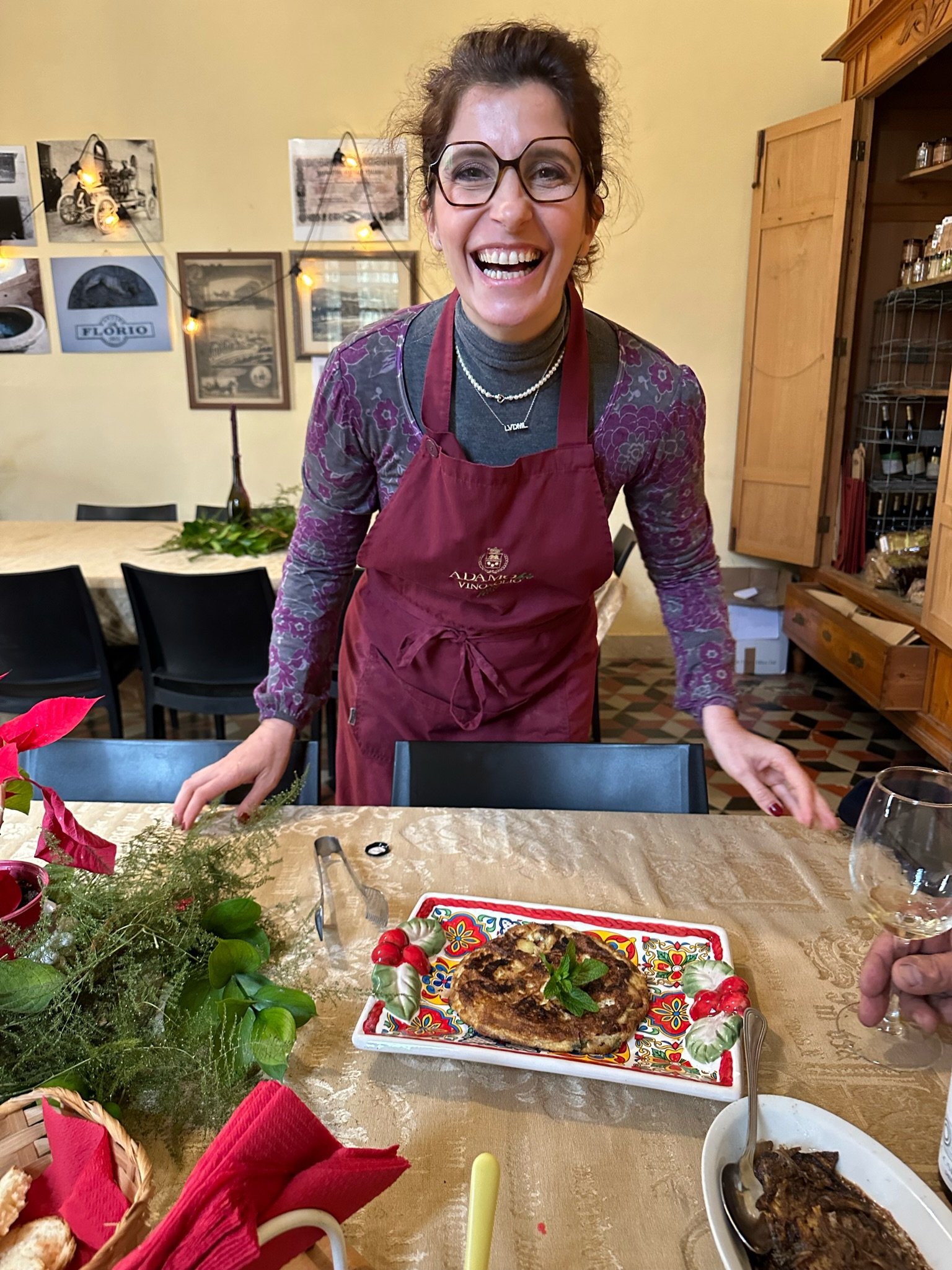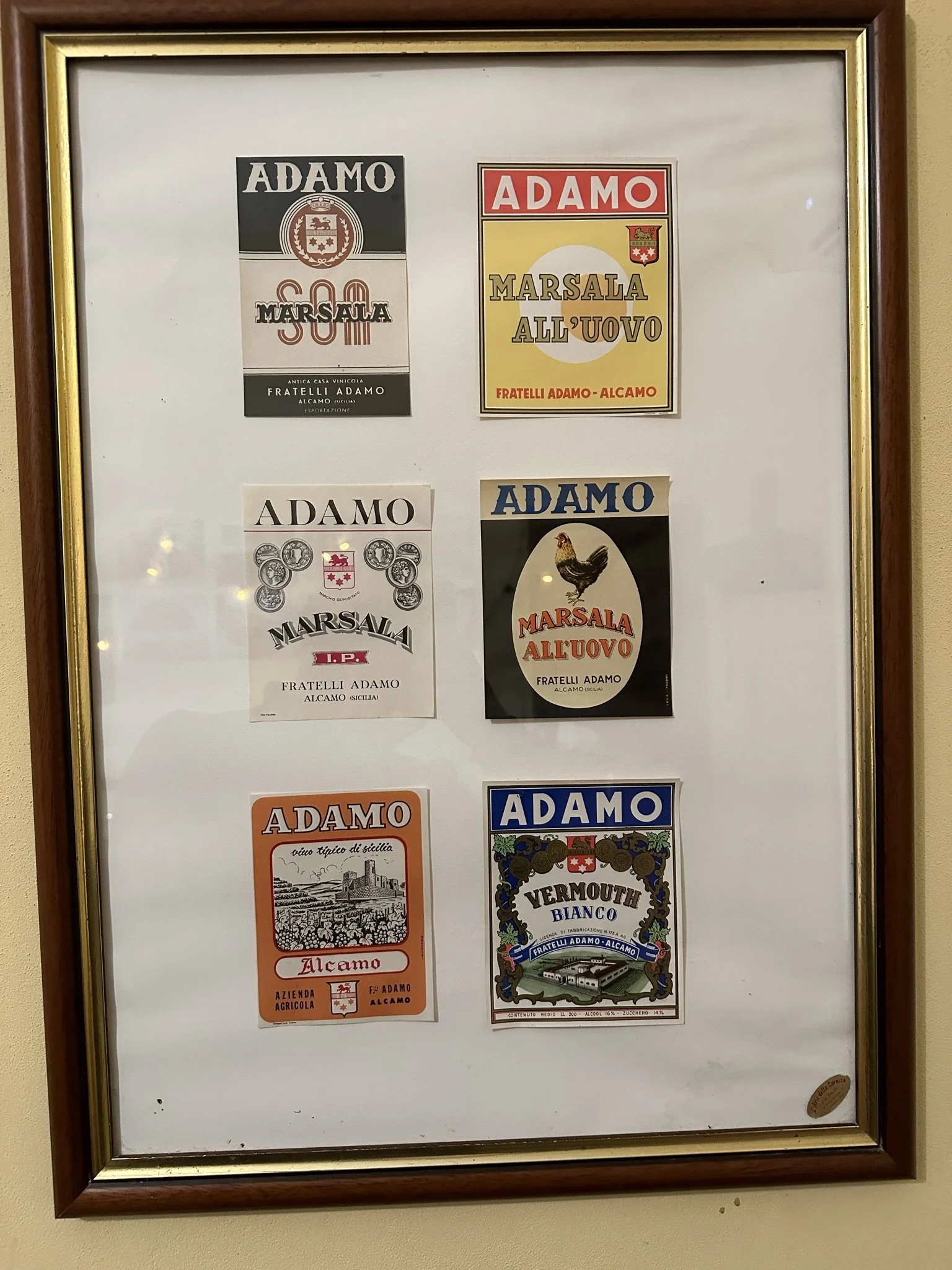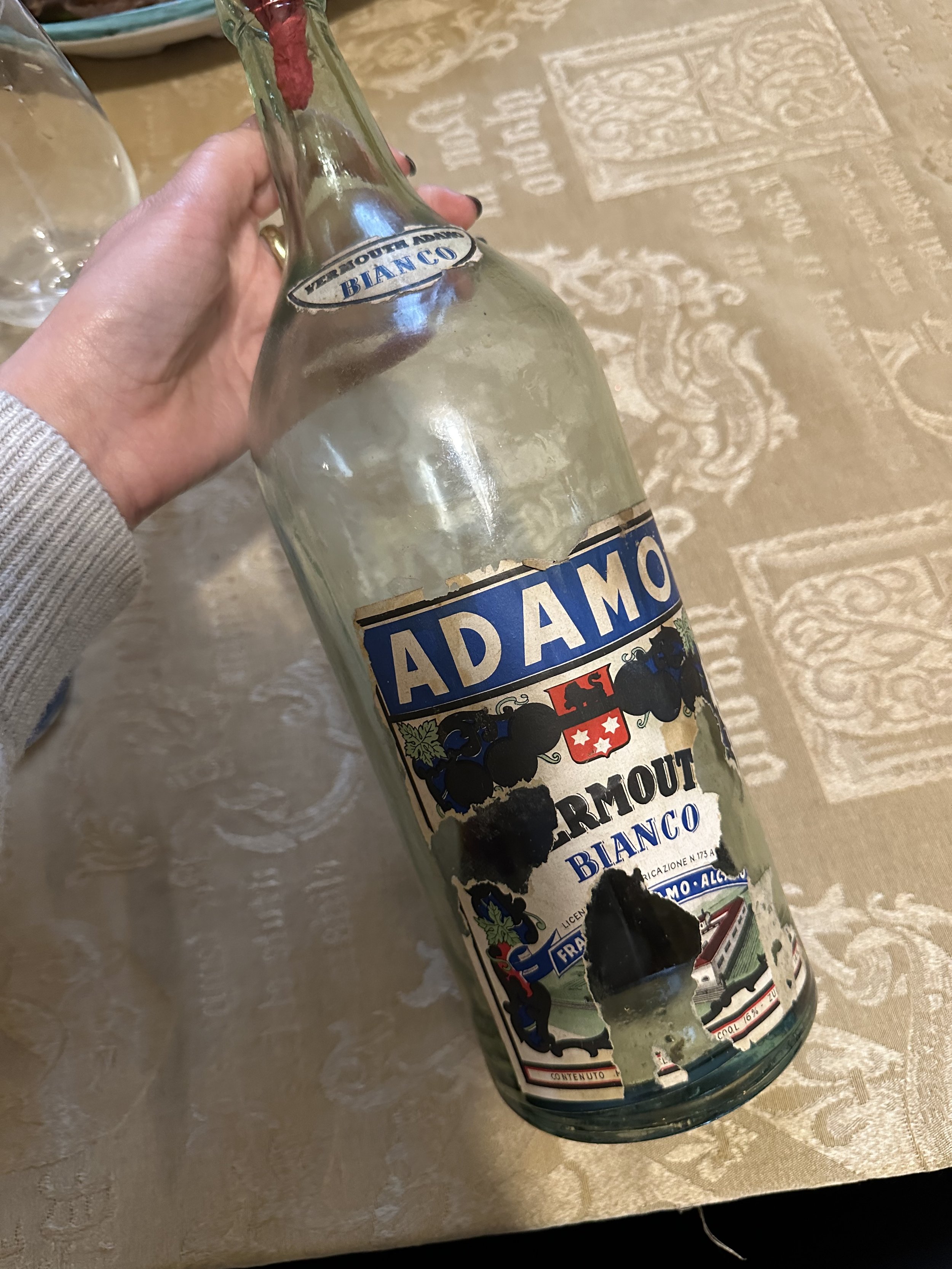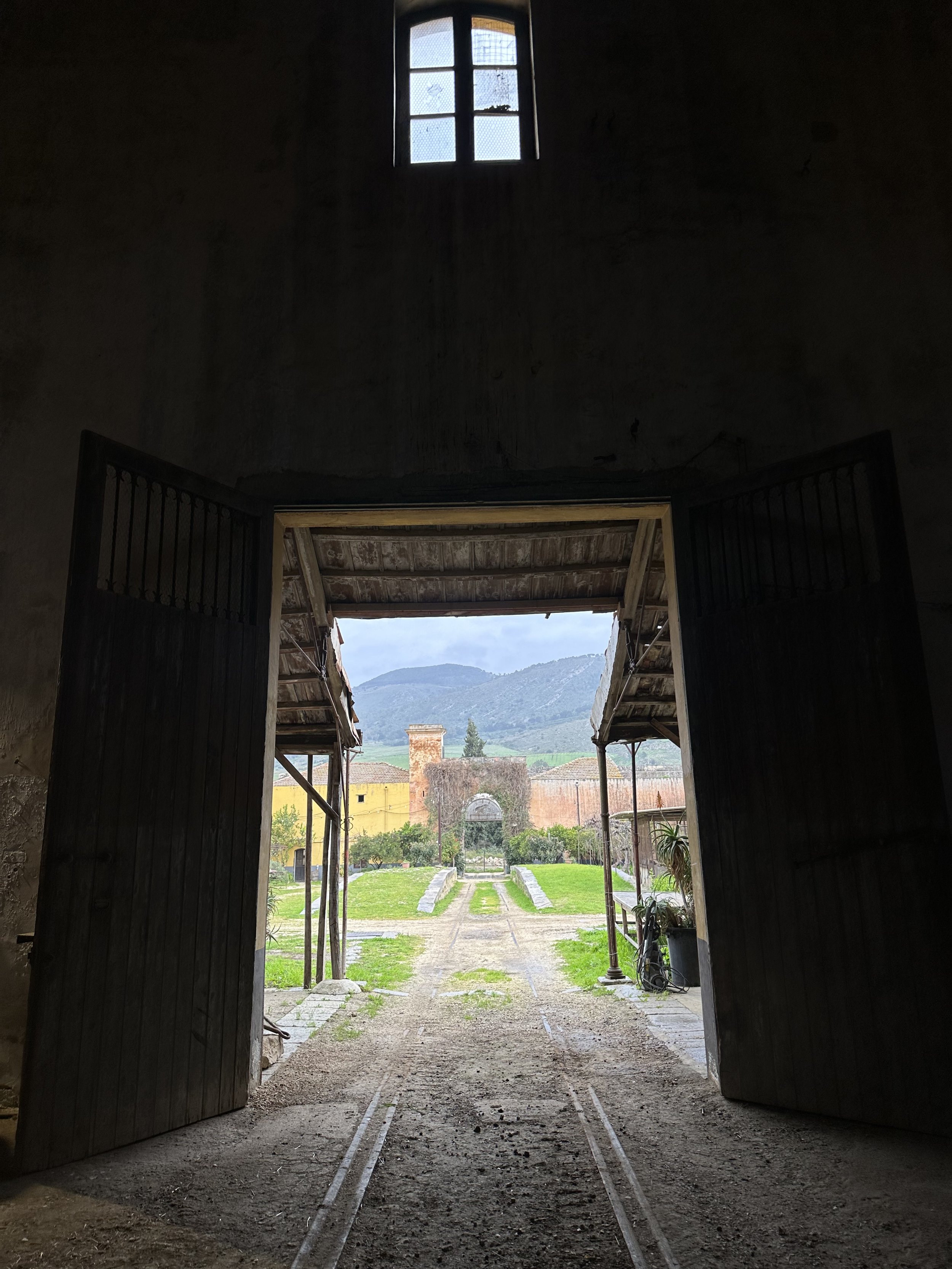Adamo Bio
The west coast of Sicily made Sicilian wines (in)famous. Marsala usually brings thoughts of sweet, powerful, and syrupy wines that you use to bake or cook with, but rarely for drinking.
Marsala’s fortified wines were driven by British demand, but the family that made them most famous was the Florios. A name I appreciate for the entrepreneurial spirit it embodies. The Florios helped take Sicily out of the feudal states that were the heritage of British Colonial rule.
On our way from Palermo to our week stay in Trapani, we get our first experience of the Florio legacy when we stop at Adamo Bio, a farm recommended by one of Andrea’s colleagues. We passed the Consortio San Francisco (a huge factory of a wine consortium), and started driving down a half-broken pavement half-dirt road, parallel to the railroad tracks. The road runs between the tracks and abandoned factories that feel 150+ years old.
Eventually, we pulled up alongside one of these factories and park between the tracks and the massive doors leading into the building. The rain is coming down, and as we rush inside, we can’t help to notice the rusted perpendicular tracks leading from the train tracks through these massive doors.
Husband and wife duo, Vincenzo and Lilyana greet us in the alcove before the huge open square created by the factory structure. The building is a massive hollow square with interior and exterior walls creating the structure. The structure is ~25 feet wide for the facade, but its hard to see the full scope of the building from where we stand. Doors to our left and to our right open into the structure itself, with kitchen on oneside and tasting room/dining room on the other. Before heading into the tour, the two check if we will want lunch as well and asks if we eat everything - I share Andrea is “senza carne” or vegetarian, and they both nod with ease, saying “va bene.”
Vincenzo starts us on our tour and overview of the property by taking us toward the train tracks and station just outside the building. He has his own lock on the gate, even though this is clearly a goverment owned train track. We walk through the gate and he points to a huge metal plate on the ground - this is where we turn the trains off the tracks into the warehouse. This plate is huge and completely rusted over. In the center is the Florio symbol and the date 1858 stamped into it.
Vincenzo walks us across the tracks to the old Alcamo train station - it has been closed for decades, and a new one built a few kilometers away. It’s a charming building, still with the women’s bathroom signs, and I could see it being a trendy hotel one day. Vincenzo points out some weed-looking plants that are edible before grabbing a few to take back to Lilyana, who is back cooking.
Vincenzo runs a farm and also happens to now make wine. He doesn’t have a winery or any equipment, so he uses his friend’s and neighbor’s winery across the train tracks.
We go in, and the winemaker is still cleaning equipment they’ve been using the past few days.
Vincenzo walks us over to the massive steel tanks where he has created his organic and biodynamic wines, snags a couple of winemaker glasses, and starts loosening the taps.
First up is the Cataratto - hazy and fresh smelling out of the tap, this wine is only a few weeks into its vinification in steel tanks. It won’t ever see oak, as Vincenzo likes to preserve the purity of the wines. His wines only see stainless steel or cement. They also rapidly cool down the grapes from about 40 degrees C outside to 15 for white and 20 for red.
We taste our first Perricone with Vincenzo. It is a late October, early November harvest, nearly unheard of in the states for anything but Icewine (Late harvest, high sugar style). The wine straight out of the tank is young, but it hints at a future great bottle with a deep flavor of dark red fruits and some umami.
After the barrel tasting, Vinzeno walks us back across the train tracks and into to the tasting room. We tour the tasting room and bottle shop, admiring the incredible history of this building, this family, and this wine. Vincenzo shares that his family owned this factory and farm after one generation of Florio’s. They have been making wine here since nearly 1900. His great-grandfather received an award from the King of Italy. But Vicenzo is making this wine his own style, and brand. He has modernized the branding, with the help of Lilyana’s artist friend, and started moving the wine into the more boutique, small production style we are seeking.
While he is finishing his family history, Lilyana starts to bring out platters of what she had been cooking during our hour+ tour. There is cheese with a jelly made from nero Da’vola. She puts down a huge plate of spiral pasta with pesto, wild fennel, almonds, and garlic. A vegetarian baked fritatta with potato. Fried chickpeas - Panelle style - and fried potato - Crocchè - . Caponata made with apples, instead of eggplant, that is a revelation - we are still searching for a recipe but we linked one above we are going to try!
We are blown away by this feast and shower Lillyana with “mmm’s” and “wow’s” and lots of “grazie mille” - cooking is certainly this women’s passion and talent, everything tastes fresh and delicious.
Make it stand out
To finish the meal, Vincenzo runs back to the kitchen and returns with a magnum size bottle with block-lettered “ADAMO” on the top of a haggard-looking bottle of Vermouth Bianco. The bottle is over 50 years old with only about 2” of liquid left. VIncenzo’s grandfather made this, and he brings it out for special occasions.
Heading out of the tasting room we turn into the huge interior courtyard - i’ts 60 yards deep by easily 75-100 yards wide. This massive structure is all theirs.
Vincenzo leads us around the corner into the first door on our right, directly behind the tasting room. It’s a 150-year-old wine museum without any of the pomp or circumstance. Old barrels, old cement vats, old tractors, old everything hanging on the walls of the once massive Marsala-focused winery.
The hour-long walk around the facility shows off the sheer scale of the Marsala production under the Florio and Adamo family. Cement cylinders used to age wine that stretch 20+ feet into the air and 15 feet wide line the entire back of the structure. An aging section that resembles more of a small Costco than any winery I’ve ever entered. None of it used in the past 50+ years. We are walking through the time, through the memory of an industry long gone.
Andrea, with her eye for events, starts to talk to Vicenzo about how to turn this place into the most instagrammable wedding venue in Sicily. It’s gorgeous and the history oozes out of every cracked wall and over the original stone walkways that line the stalls where farmers used to bring their grapes.
It is a perfect introduction to the Florio legacy and the broader Trapani/Marsala region.
After nearly three hours enjoying the wine and history of this beautiful facility and family, we start to make our goodbyes. We snag a few bottles of wine - some of the grillo, cataratto, perricone, and a bottle of what we think is Nero d’Avola but Vincenzo gave us one without a label.
We are off to Trapani for a week overlooking the mediteranean with half a case of wine and two new friendships.
Donnafugata - a brief stop with the Queen of Marsala
Before we move on to the next region, I told Andrea that we had to stop at arguably one of the most famous Sicilian and Marsalan producers for a tasting - Donnafugata. I mean, these people are so famous they are doing collaborations with Dolce & Gabbana. As our tasting guide told us, he even got to serve the D&G X Donnafugata wines at a Kardashians wedding…
They are a large, but high-quality producer, that has helped the Sicilian resurgence. While we don’t plan on selling Donnafugata - they are already distributed around the globe - we still stopped in to see their gorgeous facility, learn a bit about their history, and taste their delightful wines.
If you get a chance to pick up their wines at the store, they are a great expression of Sicilian wines.




























